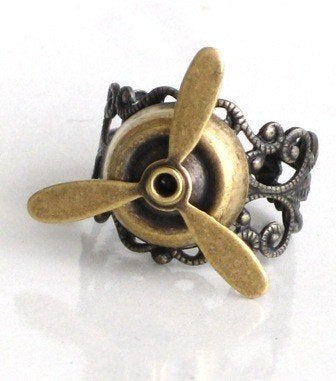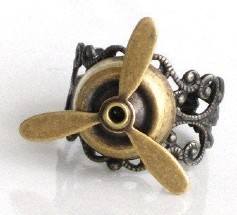
NEW YORK – With its roots in the Victorian era and the fantastical writings of authors H.G. Welles and Jules Verne, the steampunk style marries art, science, technology and design. By separating objects from their original intended purpose, steampunkers create a new vision for these objects, putting them together in new ways. Transcending its beginnings, the steampunk aesthetic has a growing cult following that appreciates it in all its forms: jewelry, fashion, artworks and functional or decorative items.
At its essence, steampunk attempts to harness Victorian design for projects that never existed in the 19th century. Its Wikipedia entry defines it as “a retrofuturistic subgenre of science fiction that incorporates technology and aesthetic designs inspired by 19th-century industrial steam-powered machinery.”
A perfect contrast of whimsy and form, minimalism and intricate construction, ingenuity and homage to old-world craftsmanship, steampunk objects have the wow factor and are just interesting to look at. Particularly appealing are see-through mechanical clocks and machines as well as elaborately constructed artful objects outfitted with all manner of decorative touches, from springs to Pez heads to gauges.

Steampunk has spread its influence into nearly every corner of culture and society from couture to movies like Hugo and Wild Wild West. Artist group Kinetic Steam Works twice brought a functioning steam engine to the Burning Man festival in the mid-2000s and if you search for steampunk on the e-commerce website Etsy, you get over 300,000 hits. Bruce and Melanie Rosenbaum have remodeled their 1901 Massachusetts home to become what is said to be the world’s first functional Steampunk home.

There is no such thing as a steampunk antique but many inventors and artists take antique objects or machines and transform them (or select parts) in wildly imaginative ways. The late Canadian artist Glenn Elliot (1941-2017) is one of several artists who has embraced the steampunk aesthetic in his work. He specialized in mechanical steampunk clocks, incorporating a variety of found objects from toy trucks and billiard balls to a pair of pliers or scissors.

Philadelphia inventor Jack Zylkin of USB Typewriter adapts old manual typewriters for use as keyboards on any USB-capable computer. Enjoying the clickety-clack of the typewriter while remaining dependent on digital devices, he created a hybrid from a typewriter he rescued off the curb near his home. The end result was an analog typewriter that would work in the digital era.
He told Auction Central News in an earlier article, “I wouldn’t call myself a steampunk – I don’t dress up with a monocle and a bowler hat – although I think that kind of fashion is cool. For me, it’s about the spirit of industriousness and inventiveness. I think people respond to it because it’s not mass-produced. What I do is high tech, but it’s a personal kind of high tech.”
As a source for vintage material to steampunk, Kamelot Auctions has offerings that go far beyond the usual industrials and architecturals. Some are easy to repurpose and others require a bit of imagination to see an object in a new light.

Joe Holahan, a partner in Kamelot Auctions in Philadelphia, said, “What’s interesting about steampunk is that historically – from a dealer perspective – the kind of dealer who would buy Victorian and the kind of dealer who would buy industrial have nothing in common. It’s interesting to see the two different profiles come together. I’ve never walked into a shop that called itself a steampunk store, but it’s cool stuff. I’ve been in the business for 25 years, and I’m always thinking, what’s next? So this makes sense – it’s stuff that’s been done, but it’s being reinvented in a new form.”
Auction houses like Kamelot Auctions and Material Culture have found success in cultivating a clientele that has a penchant for buying unusual objects. Both unsurprisingly are located in Philadelphia, where there is a wealth of architectural salvage as city buildings were demolished, then rebuilt, and factories closed. There are also plenty of great items to be found all over, from big cities to small towns, ripe for upcycling and repurposing in the steampunk style. Millennials and young couples often have a passion for steampunk items to use as everyday objects in their homes, and this movement shows no signs of slowing.



